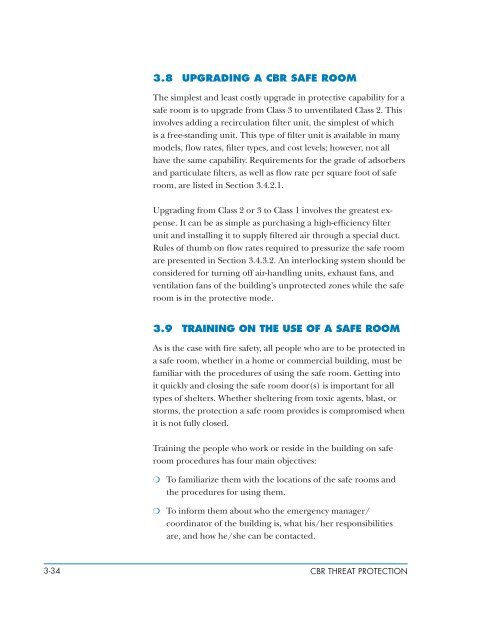FEMA 453 Design Guidance for Shelters and Safe Rooms
FEMA 453 Design Guidance for Shelters and Safe Rooms
FEMA 453 Design Guidance for Shelters and Safe Rooms
You also want an ePaper? Increase the reach of your titles
YUMPU automatically turns print PDFs into web optimized ePapers that Google loves.
3.8 UpGRaDinG a CBR SaFe RooM<br />
The simplest <strong>and</strong> least costly upgrade in protective capability <strong>for</strong> a<br />
safe room is to upgrade from Class 3 to unventilated Class 2. This<br />
involves adding a recirculation filter unit, the simplest of which<br />
is a free-st<strong>and</strong>ing unit. This type of filter unit is available in many<br />
models, flow rates, filter types, <strong>and</strong> cost levels; however, not all<br />
have the same capability. Requirements <strong>for</strong> the grade of adsorbers<br />
<strong>and</strong> particulate filters, as well as flow rate per square foot of safe<br />
room, are listed in Section 3.4.2.1.<br />
Upgrading from Class 2 or 3 to Class 1 involves the greatest expense.<br />
It can be as simple as purchasing a high-efficiency filter<br />
unit <strong>and</strong> installing it to supply filtered air through a special duct.<br />
Rules of thumb on flow rates required to pressurize the safe room<br />
are presented in Section 3.4.3.2. An interlocking system should be<br />
considered <strong>for</strong> turning off air-h<strong>and</strong>ling units, exhaust fans, <strong>and</strong><br />
ventilation fans of the building’s unprotected zones while the safe<br />
room is in the protective mode.<br />
3.9 TRaininG on THe USe oF a SaFe RooM<br />
As is the case with fire safety, all people who are to be protected in<br />
a safe room, whether in a home or commercial building, must be<br />
familiar with the procedures of using the safe room. Getting into<br />
it quickly <strong>and</strong> closing the safe room door(s) is important <strong>for</strong> all<br />
types of shelters. Whether sheltering from toxic agents, blast, or<br />
storms, the protection a safe room provides is compromised when<br />
it is not fully closed.<br />
Training the people who work or reside in the building on safe<br />
room procedures has four main objectives:<br />
m To familiarize them with the locations of the safe rooms <strong>and</strong><br />
the procedures <strong>for</strong> using them.<br />
m To in<strong>for</strong>m them about who the emergency manager/<br />
coordinator of the building is, what his/her responsibilities<br />
are, <strong>and</strong> how he/she can be contacted.<br />
3-3 CBR ThReaT pRoTeCTion

















